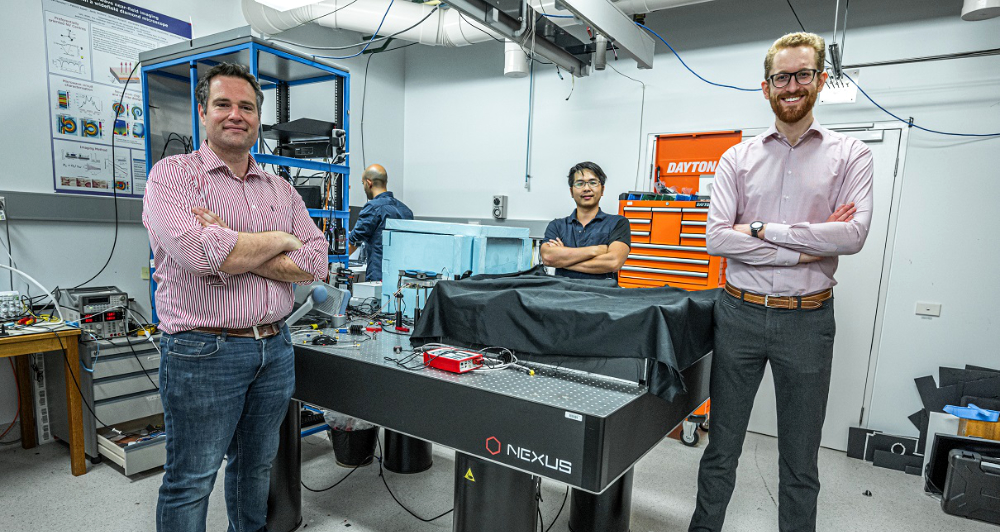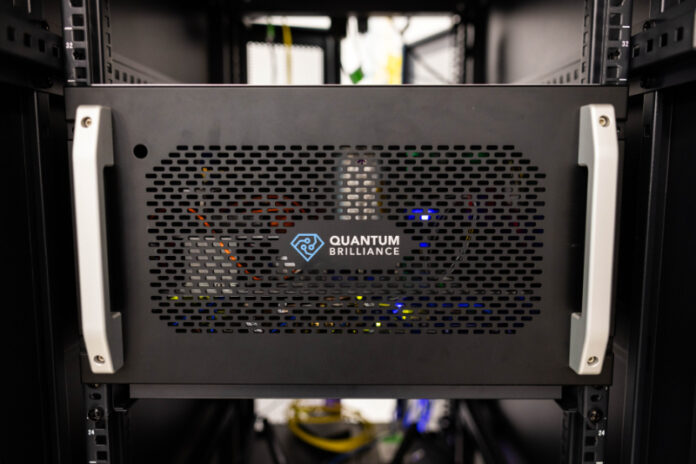For many enterprise users, quantum computing remains a technology buzzword, which has yet to fully realise its potential. While emerging technologies like AI or ML are already addressing numerous challenges across industries, conversations surrounding quantum computing mostly focus on its possibilities rather than its current capabilities.
Quantum Brilliance, a quantum computing hardware company established in 2019, is aiming to reframe the way enterprises think about the technology, one qubit at a time.
Frontier Enterprise spoke with Dr Mark Mattingley-Scott, Chief Revenue Officer at Quantum Brilliance, to unravel the intricacies of quantum computing.
According to your website, quantum computing is already available commercially, while others believe it is still a long way off. What have you guys done that hasn’t been done before?
I believe there is a potential for quantum computing to deliver tangible commercial benefits. To construct a business case centred around quantum computing, there must be a noticeable improvement in performance in various aspects, such as speed, precision, or energy efficiency. In order to establish a solid business case, it is essential to demonstrate that quantum computing can outperform classical alternatives in terms of cost-effectiveness, efficiency, or accuracy.
One area that the entire industry is actively pursuing is the examination of algorithms. The goal is to identify areas where performance can be enhanced without immediate consideration of costs. Currently, the focus is on consuming quantum computing in the cloud without a thorough analysis of associated expenses, including operational costs and capital expenditure (CAPEX). However, it is important to acknowledge that at some point, there will be a need to make purchases or use cloud services, which incur costs.

The cost issue is complex, mainly due to the nature of the delivery model. If a company focuses on superconducting, trapped ions, cold atoms, or photonics in the field of quantum computing, significant infrastructure is required. This infrastructure involves maintaining very low temperatures, ultra-high vacuums, and precise laser systems. Acquiring and operating this infrastructure involves capital expenditure (CAPEX). Additionally, these systems typically consume kilowatts or more of power, making it challenging to significantly reduce operational expenses. Therefore, this aspect plays a role in the overall business case.
The two key considerations are the performance benefits and the associated costs. Many industry observers believe that current quantum computing efforts primarily focus on algorithm exploration without considering the economics. However, our approach is fundamentally different. The technology we employ is designed to be manufacturable, with the complexity concentrated in the materials and manufacturing process. Our aim is to mass-produce a small, energy-efficient solution.
Given these circumstances, the relevant economic equation for establishing a business case shifts. Instead of solely focusing on algorithms and the number of qubits required to solve complex problems, we prioritise identifying simple use cases that can leverage our technology with a smaller number of qubits. The goal is to find the inflection point where even with 100 qubits, useful tasks can be accomplished, improving accuracy, speed, or energy efficiency to some degree. Our belief is that this incremental approach will define the future of quantum computing.
Will the majority of the costs be attributed to superconducting, supercooling, and energy requirements associated with the other models you mentioned?
The extent of cost depends on the underlying technology. Generally, it revolves around three or four key factors. Firstly, achieving extremely low temperatures, ranging from millikelvin for Josephson junctions to nanokelvin for cold atoms. Secondly, ensuring a high level of vacuum, which requires multiple pumps and complex infrastructure to achieve and maintain.
Additionally, mechanical and electromagnetic isolation may be necessary for certain technologies. Another aspect to consider is the need for ultra-precise lasers, which tend to be energy-intensive and require adequate space. The specific combination of these factors, including lasers, vacuum systems, dilution refrigerators, shielding, and more, determines the overall requirements. However, it is important to note that all of these elements currently consume a significant amount of energy.
Returning to Quantum Brilliance and its use of nitrogen vacancies in diamond, we believe that this technology offers a distinct advantage. It requires no infrastructure and is highly amenable to miniaturisation, enabling mass production. As a result, we are presented with an entirely different economic equation. We can now focus on identifying the first problem where we can achieve economic benefits using just 100 qubits and then proceed accordingly.
At the Pawsey Supercomputing Centre in Perth, Australia, we currently have a prototype machine housed in a 19-inch rack situated next to a supercomputer. This environment is known to be hostile, particularly in terms of acoustics, with high levels of vibration and noise. Most other quantum computing technologies would not be viable in such conditions, but our machine thrives in this environment.
At the moment, when you talk to customers, is the path from high-performance computing towards quantum computing? What sort of potential customers are you guys most engaged with?
In an ideal world, we would be engaging with companies that require complex analytics or processing of data at the source. This includes discussions about quantum computing at the edge, such as IoT Edge, vehicles, aerospace, robotics, and mining. These are contexts where guaranteeing connectivity or relying on the cloud is impractical. Many of the most intriguing opportunities in the world fall into this category.
While simple tasks or UX programming can be done in the cloud, numerous companies have faced challenges and even bankruptcy due to connectivity issues and the sudden loss of cloud connections at critical moments. This is particularly relevant in high-value areas of value creation within a company’s operations.
If it were possible to place a small quantum computer next to your data, those are the conversations I would love to be having with everyone. However, the narrative set by the companies at the forefront of the quantum computing revolution revolves around the need for substantial infrastructure, either through cloud delivery or on-premises data centres. Placing most quantum computing technologies within data centres is often unfeasible or downright impossible.
However, the industry narrative emphasises that it’s coming out of the cloud, which complicates our positioning since we have to frame our uniqueness in terms of cloud delivery. Ideally, I would prefer to focus discussions on the concept of quantum computing at the source of data, where our distinctive advantages truly shine. While we have not yet reached that stage, it is an area we are actively working on.
Do the algorithms vary depending on the hardware architecture of each type of quantum computer?
When discussing cloud delivery, the architecture and integration occur through a service endpoint. However, if your algorithm requires a strong and direct connection between a quantum computer and the classical repeater, that presents challenges. Unless, of course, you specifically require that tight coupling, in which case cloud providers and compute centres are more than willing to handle all the data processing on your behalf.
On the other hand, if your delivery mechanism involves a physical machine located within your compute centre, the current connection is typically a gigabit Ethernet. However, in the near future, it is anticipated that a PCI bus will provide an even tighter coupling option.
Quantum Brilliance is partially funded by the Australian Government. Can you share a little bit about your business structure?
We are funded by the Australian and German governments, which is why we have a German subsidiary. Close to half our team is based in Germany. We conduct research and development, as well as create intellectual property, in both Germany and Australia. Our operations span across both continents, encompassing sales and market activities.

Additionally, we have expanded our presence to Singapore as part of our long-term strategy to establish an international footprint. Singapore serves as an excellent launch pad due to its stable legal system, high reliability, enforceable contracts, and significant investment opportunities. Moreover, Singapore acts as a gateway to the ASEAN region, offering a wealth of skilled talent. So Singapore, for us, is the first step into becoming truly international.
Is the company looking to get really big with commercialising the technology? Are you looking to exit at some point in the near future?
A substantial amount of funding is being directed toward quantum computing, particularly in Germany, which recently announced an additional 3 billion EUR dedicated to the field. While other countries may not be matching these numbers precisely, Germany is certainly making significant investments in quantum computing. Although there is still considerable work to be done on the underlying hardware, there is also a pressing need to bridge the gap between the technology and its business benefits. Currently, the industry and customers tend to focus on theoretical aspects more than practical business benefits. From our perspective, we prefer engaging in discussions that accelerate our progress in achieving even the smallest business advantages.
We are actively exploring opportunities in countries like India, Vietnam, or Malaysia, which possess large populations and highly skilled individuals. Quantum computing will undoubtedly become a reality. Will it happen next month? No. Will it take 30 years? Yes. However, the inflection point where things start to transform may not be as distant as we imagine. One thing to concentrate on is the opportunity to become a brain trust in quantum computing, particularly in terms of effectively utilising quantum computers productively. I’m convinced that at the inflection point, which is not too far in the future, the world will be split into two groups— those who are leading and leveraging quantum computing and those who are forced to adapt to circumstances beyond their control. This transformation will be akin to the advent of transistors, the internet, or the telephone. Quantum computing will revolutionise every aspect of our lives, creating winners and losers. To ensure that you are on the winning side, it is imperative to understand the technology’s intricacies right now.
















